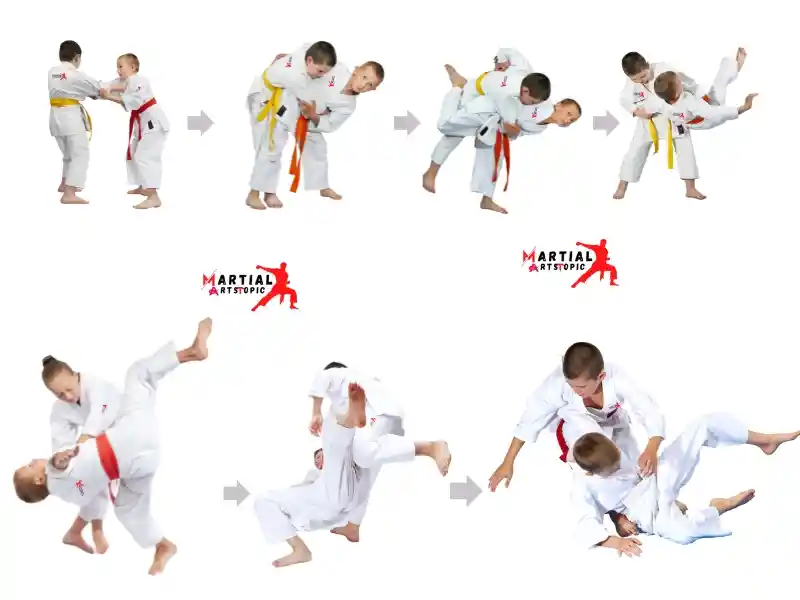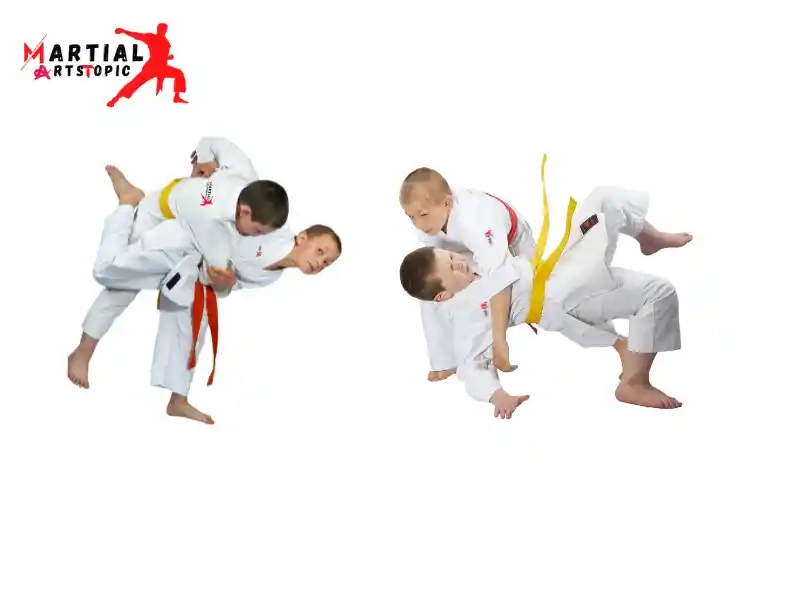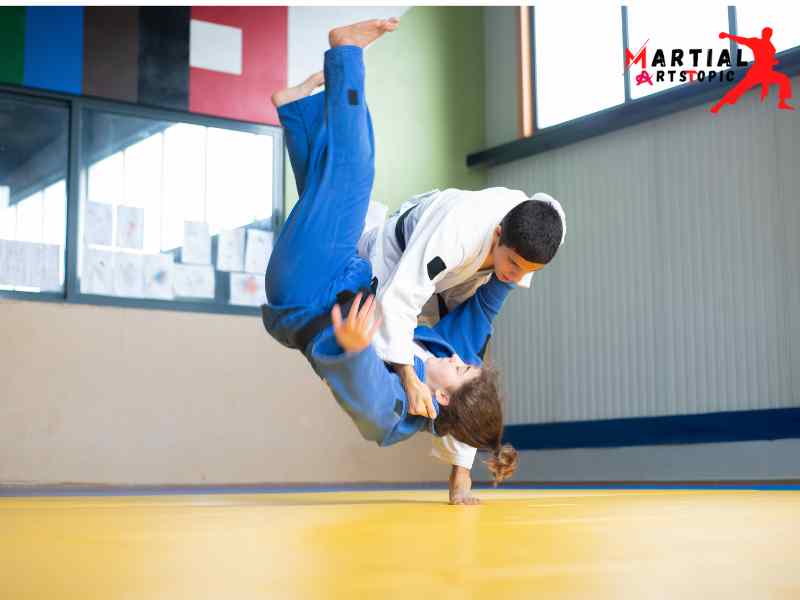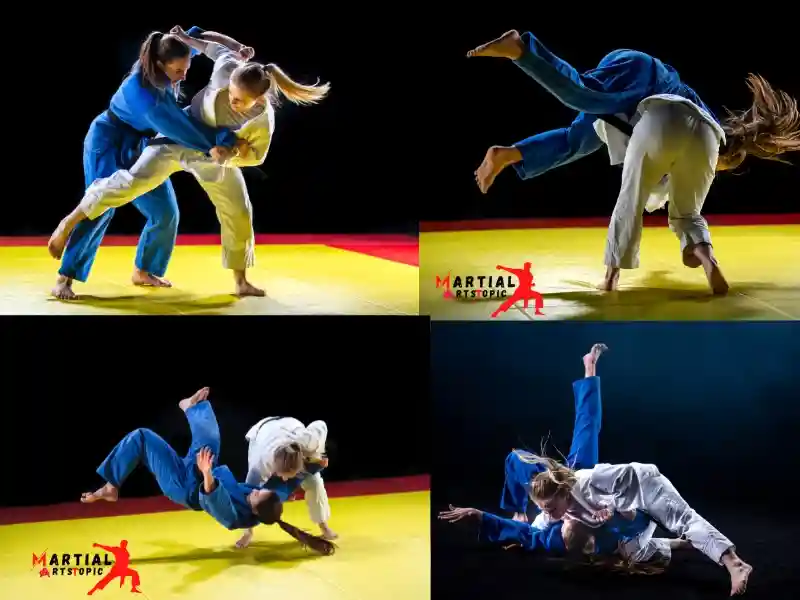
Understanding the Fundamentals of Judo Throws
Understanding the Fundamentals of Judo Throws judo is a martial art that focuses on takedowns and throwing techniques to immobilize or subdue an opponent. Judo throws are an essential component of this art, and mastering them requires a deep understanding of the key principles behind their execution.
Key Principles of Judo Throws
Proper Posture: The foundation of a successful Judo throw lies in maintaining a strong posture. This involves keeping the back straight, the feet grounded, and the body centered to generate maximum power and control during the throw.
Balance: One of the fundamental principles of Judo is disrupting the opponent’s balance to create an opening for a throw. By understanding the concept of kuzushi (off-balance), judokas can effectively execute throws with minimal effort.
Timing: The precise timing of a Judo throw is crucial for its success. It involves seizing the right moment when the opponent’s balance is compromised and capitalizing on the opportunity to execute the throw with maximum efficiency.
Importance of Proper Posture, Balance, and Timing
Proper posture, balance, and timing are interconnected elements that play a pivotal role in the seamless execution of Judo throws. Without these fundamental principles, the effectiveness and success of the throws can be compromised. It is essential for judokas to focus on developing and refining these aspects to enhance their throwing techniques.
Common Mistakes to Avoid
Learning Judo throws can be challenging, and there are common mistakes that practitioners should be mindful of:
- Relying solely on upper body strength: Judo throws require a combination of upper and lower body coordination. Over-reliance on upper body strength can hinder the effectiveness of the throw.
- Neglecting kuzushi: Failing to disrupt the opponent’s balance before attempting a throw can result in unsuccessful execution and potential vulnerability.
- Lack of timing: Poor timing can lead to missed opportunities for executing a successful throw, emphasizing the importance of honing this aspect of Judo techniques.
list of Judo Throws
Judo throws are an essential component of the martial art, offering practitioners a powerful way to take down their opponents while maintaining control. From the dynamic hip throw (O-Goshi) to the forceful shoulder throw (Seoi-Nage), there are numerous throws to master. Each throw requires precise timing, balance, and technique, making them both challenging and rewarding to learn. By incorporating these throws into your practice, you can enhance your overall Judo skills and gain a deeper understanding of the art’s principles. Whether you’re a beginner or an experienced Judoka, exploring and perfecting these throws can greatly enrich your martial arts journey.
Basic Throws

list of Judo Throws: A Comprehensive Guide to Essential Techniques. Are you ready to elevate your Judo game and master a wide range of throws? In this comprehensive guide, we will explore a diverse selection of Judo throws, from the fundamental to the advanced, providing you with the knowledge and techniques to enhance your skills on the mat. Whether you’re a novice looking to expand your repertoire or a seasoned practitioner aiming to refine your throws, this guide has something for everyone.
Tai Otoshi – Body Drop
Let’s start with Tai Otoshi, also known as the Body Drop. This classic Judo throw involves using your body to unbalance your opponent and execute a swift and controlled takedown. Mastering the Tai Otoshi requires precise timing and footwork, making it an essential technique for any Judoka aspiring to advance their throwing proficiency.
Kouchi Gari – Minor Inner Reaping Throw
Next, we have Kouchi Gari, the Minor Inner Reaping Throw. This technique focuses on using the inner part of your foot to reap your opponent’s leg, destabilizing their balance and setting them up for a decisive throw. With proper execution, Kouchi Gari can be a game-changing maneuver that catches your opponent off guard and secures a strategic advantage in the match.
Ippon Seoi Nage – One Armed Shoulder Throw
Moving on to Ippon Seoi Nage, the One Armed Shoulder Throw. This dynamic throw emphasizes using leverage and momentum to execute a powerful shoulder throw with precision and finesse. By honing your Ippon Seoi Nage technique, you can confidently launch your opponent over your shoulder, showcasing your mastery of this iconic Judo throw.
O Goshi – Major Hip Throw
Now, let’s delve into O Goshi, the Major Hip Throw. As one of the core techniques in Judo, O Goshi demands a strong grasp of hip movement and proper positioning to execute a seamless and impactful throw. By harnessing the force of your hips, you can execute O Goshi with efficiency and control, asserting your dominance on the mat with this fundamental Judo throw.
Ouchi Gari – Major Inner Reaping Throw
Up next is Ouchi Gari, the Major Inner Reaping Throw, which focuses on utilizing your foot to reap your opponent’s inner leg and execute a decisive takedown. With precise timing and technique, Ouchi Gari can be a formidable weapon in your Judo arsenal, allowing you to outmaneuver your opponent and seize the advantage during a match.
Sasae Tsurikomi Ashi – Propping Ankle Throw
Sasae Tsurikomi Ashi, the Propping Ankle Throw, offers a unique approach to destabilizing your opponent’s balance by leveraging their ankle and executing a proficient takedown. This throw requires finesse and dexterity to effectively disrupt your opponent’s stance and create an opening for a successful throw, making it a valuable addition to your repertoire of Judo techniques.
Hiza Guruma – Knee Wheel
Enter Hiza Guruma, the Knee Wheel, a throw that emphasizes using your knee to sweep your opponent off balance and execute a decisive takedown. By mastering the intricacies of Hiza Guruma, you can capitalize on opportunities to outmaneuver your opponent and assert your control during a Judo match, showcasing your proficiency in executing this impactful throw.
Morote Seio Nage – Two Armed Shoulder Throw
Morote Seio Nage, the Two Armed Shoulder Throw, is a dynamic technique that involves leveraging both arms to execute a powerful shoulder throw with precision and force. By refining your Morote Seio Nage skills, you can confidently maneuver your opponent into position and execute a decisive throw, demonstrating your mastery of this essential Judo technique.
Koshi Guruma – Hip Wheel
Koshi Guruma, the Hip Wheel, places a strong emphasis on using your hip to execute a smooth and controlled throw that capitalizes on your opponent’s balance and positioning. With proper execution, Koshi Guruma can be a game-changing maneuver that showcases your prowess in executing this fundamental Judo throw with finesse and precision.
Tani Otoshi – Valley Drop
Tani Otoshi, also known as the Valley Drop, introduces a unique approach to executing a throw by leveraging your opponent’s movement and positioning to create an opportunity for a swift and effective takedown. By mastering the subtleties of Tani Otoshi, you can strategically maneuver your opponent and execute this dynamic throw with confidence and precision, asserting your dominance on the mat.
Kouchi Sutemi – Minor Inner Sacrifice
Finally, we have Kouchi Sutemi, the Minor Inner Sacrifice, which offers a strategic approach to sacrificing your position in order to execute a dynamic throw that catches your opponent off guard. By mastering the art of Kouchi Sutemi, you can surprise your opponent with a calculated sacrifice throw, showcasing your skill and agility in executing this unconventional yet effective Judo technique.
Intermediate Throws

list of Judo Throws: A Guide to Intermediate Techniques. Are you looking to elevate your judo skills and add a powerful array of throws to your repertoire? In this comprehensive guide, we will explore a diverse selection of intermediate judo throws that will take your grappling game to the next level. From the dynamic Kata Guruma to the deceptive Knee Pump Fake, these techniques require precision, timing, and agility to execute effectively.
Kata Guruma – Shoulder Wheel
The Kata Guruma, also known as the Shoulder Wheel, is a dynamic throw that demands strength and timing to execute with finesse. This powerful technique involves lifting your opponent onto your back and rotating them over your shoulder, creating a decisive takedown opportunity. As you master the Kata Guruma, you’ll add a formidable weapon to your arsenal, capable of catching your opponents off guard and turning the tide in your favor.
Harai Goshi – Sweeping Hip Throw
The Harai Goshi, or Sweeping Hip Throw, is a classic judo technique that showcases the art of using your hip to sweep your opponent off their feet and onto the ground. With proper technique and body positioning, the Harai Goshi can be a devastating throw, capable of disrupting your opponent’s balance and creating openings for follow-up techniques or throws. Mastering this technique will give you a powerful tool for controlling and dominating your opponents on the mat.
Osoto Gari – Major Outer Reaping Throw
The Osoto Gari, also known as the Major Outer Reaping Throw, is a fundamental technique that is widely employed in judo competition. By effectively sweeping your opponent’s leg and driving them backwards, the Osoto Gari allows you to off-balance and control your opponent with precision, setting the stage for a decisive takedown. Understanding and mastering this throw will provide you with a versatile and effective tool for asserting dominance in grappling exchanges.
One Arm Tai Otoshi – Single Arm Body Drop
The Arm Tai Otoshi, or Single Arm Body Drop, is a throw that requires finesse and timing to execute with precision. By leveraging your opponent’s momentum and using leverage to your advantage, you can perform a swift and decisive takedown with the Arm Tai Otoshi. This deceptive technique can catch your opponents off guard and create opportunities for transitioning into dominant positions on the mat.
Sumi Gaeshi – Corner Reversal
The Sumi Gaeshi, also known as the Corner Reversal, is a dynamic throw that capitalizes on your opponent’s forward momentum to reverse their direction and execute a decisive throw. This technique demands agility and quick reflexes to catch your opponent off balance and execute the throw with precision, making it a valuable addition to your grappling arsenal. As you master the Sumi Gaeshi, you’ll possess a powerful tool for turning the tables on your opponents and seizing control of grappling exchanges.
Deashi Harai – Forward Foot Sweep
The Deashi Harai, or Forward Foot Sweep, is a fundamental foot sweep that can be used to disrupt your opponent’s balance and create openings for takedowns. By sweeping your opponent’s foot out from under them, you can create opportunities to execute follow-up techniques or throws, establishing your dominance on the mat. As you refine your mastery of the Deashi Harai, you’ll gain a nuanced understanding of footwork and timing, enabling you to outmaneuver your opponents with precision and finesse.
Uchi Mata – Inner Thigh Throw
The Uchi Mata, also known as the Inner Thigh Throw, is a dynamic and powerful technique that involves lifting your opponent onto your hip and driving them over your leg. With proper timing and hip placement, the Uchi Mata can be a devastating technique, capable of catching your opponent by surprise and securing decisive takedowns. As you hone your skills in executing the Uchi Mata, you’ll wield a formidable technique that commands attention and respect on the judo mat.
Knee Pump Fake
The Knee Pump Fake is a deceptive technique that involves feinting a knee strike to create openings for throws or takedowns. By baiting your opponent into reacting to the feint, you can capitalize on their movements and execute a decisive technique with precision and timing. Mastering the Knee Pump Fake will grant you a strategic advantage, allowing you to manipulate your opponent’s reactions and create opportunities for launching powerful throws or takedowns.
Same Side Seoi Nage
The Same Side Seoi Nage is a variation of the classic Seoi Nage throw that involves attacking on the same side as your dominant hand. By leveraging precise footwork and leverage, you can execute a powerful throw, catching your opponent off guard and placing them in a vulnerable position. As you refine your technique in the Same Side Seoi Nage, you’ll possess a versatile and effective tool for controlling and dictating the flow of grappling exchanges.
Advanced Throws

list of Judo Throws: Are you ready to elevate your judo skills to the next level? In the world of judo, mastering advanced throws can set you apart as a skilled and formidable practitioner. In this comprehensive guide, we will delve into the intricacies of advanced throws, including the Tomoe Nage, Yoko Tomoe Nage, Kosoto Gari, Okuriashi Harai, Kosoto Gake, Hane Goshi, Harai Tsurikomi Ashi, and Ura Nage. Let’s explore how these dynamic techniques can enhance your judo repertoire and take your performance to new heights.
Tomoe Nage – Circle Throw
The Tomoe Nage, also known as the circle throw, is a dynamic and powerful technique that harnesses your opponent’s momentum to execute a fluid circular motion, culminating in a decisive throw. Mastering the Tomoe Nage requires precise timing, coordination, and the ability to leverage your opponent’s movements to your advantage.
Yoko Tomoe Nage – Side Circle Throw
Similar to the Tomoe Nage, the Yoko Tomoe Nage involves executing a circular throw to the side, requiring exceptional agility and control. This advanced technique demands a deep understanding of timing and the ability to seamlessly transition into the throw while capitalizing on your opponent’s vulnerabilities.
Kosoto Gari – Minor Outer Reaping Throw
The Kosoto Gari, or minor outer reaping throw, is a technique that disrupts your opponent’s balance by sweeping their leg from the outside, leading to a controlled takedown. Precision footwork and impeccable timing are essential for catching your opponent off guard and executing the Kosoto Gari with maximum impact.
Okuriashi Harai – Following Foot Sweep
The Okuriashi Harai, or following foot sweep, is a technique that involves sweeping both of your opponent’s legs while destabilizing their stance and causing a backward fall. This advanced throw demands quick reflexes and seamless coordination to effectively disrupt your opponent’s equilibrium.
Kosoto Gake – Minor Outer Hook
The Kosoto Gake, or minor outer hook, is a technique that capitalizes on hooking your opponent’s leg from the outside, using leverage to off-balance them and initiate a throw. Mastering the Kosoto Gake requires a keen sense of timing and the ability to apply strategic leverage for a successful execution.
Hane Goshi – Springing Hip Throw
The Hane Goshi, or springing hip throw, is a dynamic technique that utilizes your opponent’s momentum to execute a powerful hip throw. Precision timing and coordinated hip movement are crucial for generating the force necessary to execute the Hane Goshi with maximum impact.
Harai Tsurikomi Ashi – Lifting Pulling Foot Sweep
The Harai Tsurikomi Ashi, or lifting pulling foot sweep, involves lifting and sweeping your opponent’s foot while pulling them off balance, resulting in a backward fall. This advanced throw demands precise coordination and timing to effectively disrupt your opponent’s stability and execute a decisive takedown.
Ura Nage – Rear Throw
The Ura Nage, or rear throw, involves throwing your opponent over your back using a combination of leverage and momentum. Mastering this advanced technique requires excellent spatial awareness and timing to execute successfully.
Khabarelli Georgian Throw
The Khabarelli Georgian throw is a dynamic throwing technique that involves using your opponent’s momentum to execute a powerful hip throw. This technique requires exceptional timing and hip movement to generate the necessary force for the throw.
Modified Kata Guruma
The modified Kata Guruma is a variation of the traditional shoulder wheel throw that involves using your opponent’s momentum to execute a powerful throw. This technique requires precise timing and coordination to effectively off-balance and throw your opponent.
Takedowns from Russian Tie
Takedowns from the Russian tie involve utilizing grips on your opponent’s arm and head to execute a variety of takedown techniques. This advanced skill requires excellent control and leverage to effectively take your opponent to the ground.
Knee Osoto Gari
The knee Osoto Gari is a variation of the Osoto Gari throw that involves sweeping your opponent’s leg with your knee, causing them to lose balance and fall backward. This technique requires precise timing and footwork to execute effectively.
Ouchi Fake to Sumi Gaeshi
The Ouchi fake to Sumi Gaeshi is a deceptive throwing technique that involves faking an Ouchi Gari to set up a counter throw with the Sumi Gaeshi. This advanced technique requires exceptional timing and strategic execution to catch your opponent off guard.
Sumi Gaeshi from Russian Tie
The Sumi Gaeshi from the Russian tie is a throwing technique that involves countering your opponent’s movement from the Russian tie position to execute a dynamic throw. This technique requires quick reflexes and precise timing to effectively off-balance and throw your opponent.
Drop Ouchi Gari from High Hand
The drop Ouchi Gari from the high hand position is a technique that involves swiftly dropping to execute a low sweeping leg throw while controlling your opponent’s high hand. This advanced technique requires exceptional agility and timing to execute effectively.
Switch to Tani Otoshi
The switch to Tani Otoshi is a technique that involves transitioning from a standing position to a sacrifice throw, ultimately causing your opponent to fall over your outstretched leg. This advanced technique requires quick reflexes and precise timing to effectively execute the switch and throw.
Specialized Throws

When it comes to mastering the art of Judo, specialized throws play a crucial role in the repertoire of any skilled practitioner. These throws are not only effective in competition but also serve as essential techniques for self-defense and physical conditioning. In this comprehensive guide, we’ll explore specialized throws that every Judo enthusiast should be familiar with.
Osoto Gari (Large Outer Reap)
Osoto Gari, also known as the Large Outer Reap, is a powerful throwing technique in Judo. It involves using your leg to reap your opponent’s leg from the outside, destabilizing their balance and creating an opportunity to throw them to the ground with force.
Uchi Mata (Inner Thigh Throw)
Uchi Mata, or the Inner Thigh Throw, is a dynamic and visually impressive technique that requires precise timing and control. By lifting and rotating your opponent over your hip, you can execute a swift and impactful throw that can quickly turn the tide of a match.
Seoi Nage (Shoulder Throw)
Seoi Nage, commonly known as the Shoulder Throw, is a classic Judo technique that relies on using your opponent’s momentum and leverage to throw them over your shoulder with controlled force. It’s a versatile move that can be executed from various grips and positions, making it a staple in any Judoka’s arsenal.
Ouchi Gari (Large Inner Reap)
Ouchi Gari, the Large Inner Reap, is a fundamental throwing technique that involves sweeping your opponent’s leg from the inside, causing them to lose balance and providing an opening for a decisive throw. Its simplicity and effectiveness make it a go-to move for Judokas of all levels.
Tomoe Nage (Circle Throw)
Tomoe Nage, also known as the Circle Throw, is a visually stunning throw that requires precise timing and coordination. By using your opponent’s momentum and your own body movement, you can execute a dynamic throw that can catch your opponent off guard.
Harai Goshi (Sweeping Hip Throw)
Harai Goshi, the Sweeping Hip Throw, is a powerful and dynamic technique that involves using your hip to sweep your opponent off their feet and throw them with controlled force. It’s a move that demands proper weight distribution and timing to execute effectively.
Tai Otoshi (Body Drop)
Tai Otoshi, the Body Drop, is a swift and deceptive throwing technique that involves tripping your opponent’s leg while simultaneously using your body to create leverage and throw them to the ground. Its quick execution and unexpected nature make it a valuable technique in a Judoka’s arsenal.
Ko Uchi Gari (Small Inner Reap)
Ko Uchi Gari, the Small Inner Reap, is a precise and efficient throwing technique that involves sweeping your opponent’s leg from the inside, creating an opportunity to off-balance and throw them with controlled force. Its subtlety and speed make it a valuable tool for gaining the upper hand in a match.
Koshi Guruma (Hip Wheel)
Koshi Guruma, the Hip Wheel, is a dynamic throwing technique that requires proper hip positioning and timing to execute effectively. By using your hip as a fulcrum, you can pivot and throw your opponent with decisive force, making it a formidable technique in the hands of a skilled judoka.
De Ashi Harai (Advancing Foot Sweep)
De Ashi Harai, the Advancing Foot Sweep, is a precise and calculated throwing technique that involves sweeping your opponent’s foot while advancing, causing them to lose balance and creating an opening for a swift and decisive throw. Its strategic use can disrupt your opponent’s rhythm and create opportunities for victory.
Judo Throw Training Tips

Are you looking to improve your judo throws and take your skills to the next level? Whether you’re a beginner or an experienced judoka, mastering the art of throwing in judo is essential for success in this martial art. In this guide, we’ll provide you with valuable training tips to help you perfect your judo throws and enhance your overall performance on the mat.
- Seoi Nage (Shoulder Throw): One of the most popular and effective judo throws. Seoi Nage involves using your opponent’s momentum to throw them over your shoulder. To perfect this technique, focus on footwork, hip rotation, and maintaining a powerful grip on your opponent’s uniform.
- O Soto Gari (Major Outer Reap): O Soto Gari is a powerful throw that requires precise timing and coordination. To improve your O Soto Gari, work on developing explosive leg strength and mastering the entry and execution of the throw.
- Uchi Mata (Inner Thigh Throw): Uchi Mata is a dynamic throw that involves lifting and throwing your opponent over your inner thigh. To enhance your Uchi Mata, focus on timing, balance, and the coordination of your upper and lower body movements.
- Harai Goshi (Sweeping Hip Throw): This throw requires a strong hip movement and precise timing to sweep your opponent off their feet. Practice drills that emphasize hip rotation, foot positioning, and the speed of the throw to perfect your Harai Goshi technique.
- Tai Otoshi (Body Drop): Tai Otoshi is a throw that relies on off-balancing your opponent and executing a swift downward motion to bring them to the ground. To refine your Tai Otoshi, concentrate on controlling your opponent’s balance, maintaining a strong posture, and executing the throw with fluidity.
- De Ashi Barai (Advanced Foot Sweep): De Ashi Barai is a subtle yet effective throw that involves sweeping your opponent’s foot to disrupt their balance and execute the throw. Practice timing, precision, and coordination to master the art of De Ashi Barai.
- Ippon Seoi Nage (One Arm Shoulder Throw): Ippon Seoi Nage requires precise positioning and a strong grip to execute the throw with maximum impact. Focus on developing a stable stance, powerful rotation, and a seamless transition from gripping to throwing.
By incorporating these training tips into your judo practice, you can enhance your throwing techniques and elevate your overall performance on the mat. Remember to dedicate time to drilling each throw, focusing on both the technical aspects and the physical conditioning required for successful execution. With consistent training and dedication, you can master the art of judo throws and become a formidable force on the mat.
Conclusion
The list of Judo throws provides a comprehensive overview of the various techniques used in Judo. From the dynamic hip throws to the precise foot sweeps, each throw offers unique insights into the art of Judo. By understanding and practicing these throws, practitioners can enhance their skills and proficiency in Judo, ultimately contributing to their overall growth and development in the martial art.
